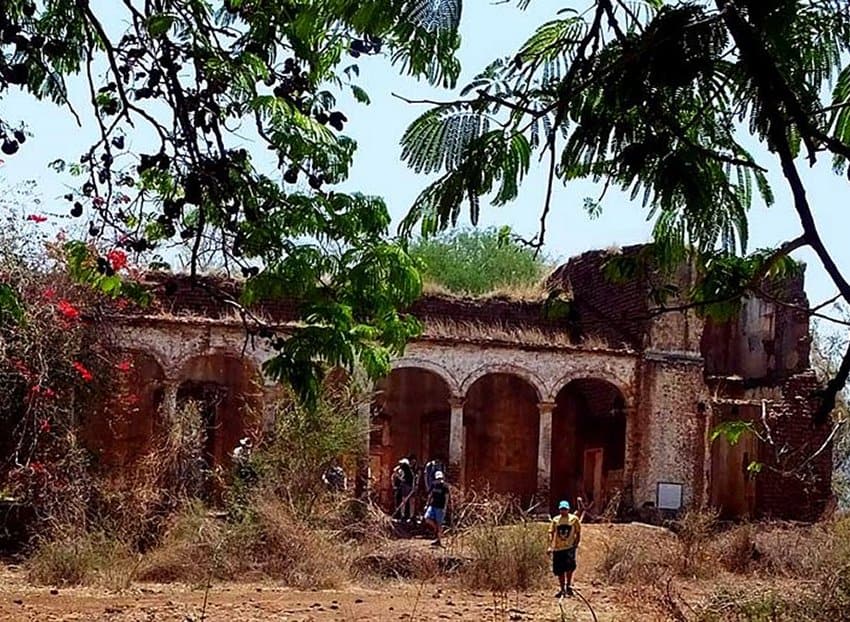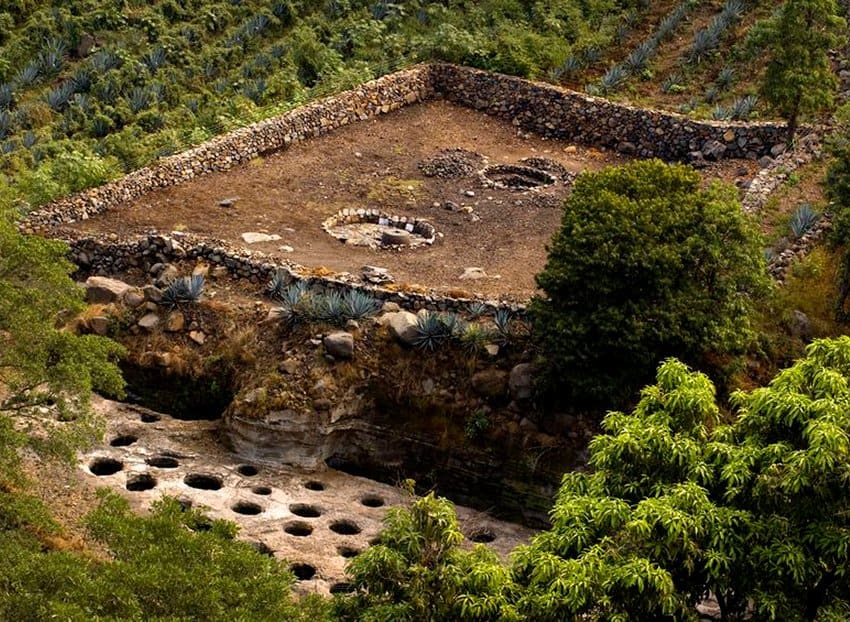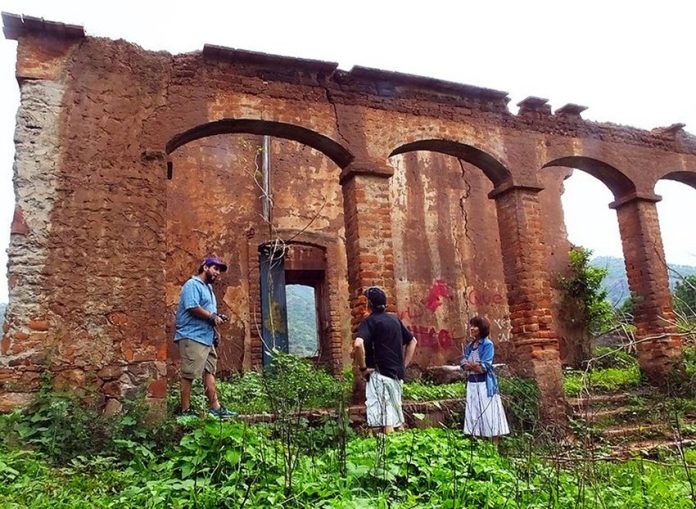Some years ago while visiting the pueblo of Amatitán, which is located 33 kilometers northwest of Guadalajara, I came upon a large map proudly displayed in the town square.
It showed the location of several tabernas or distilleries in the vicinity, claiming that Amatitán — and not that other town just down the road — is the true birthplace of tequila. This I found most interesting, and I made it my goal to visit as many of these sites as possible if I could manage to find them.
The most conveniently located of those tabernas was a place called Rancho de la Cofradía del Puente, a very impressive but now crumbling structure situated just beside a paved road. Here I found a plaque both in English and Spanish explaining that this was once a hacienda that was producing tequila as early as 1800, using primitive production systems.
The writing style and high-quality English told me that this information had been written by the late, great archaeologist Phil Weigand. “The Big House,” he says, “located in the middle of the extensive agave fields, is made up of a double corridor with three apartments that were connected by an arcade made up of nine arches held up by Tuscan pillars that today lack a roof . . . . The housing units have formal elements of the neoclassic style common in rural Jalisco in the 19th century.
“The unfortunate overall condition of the site is testimony to the lack of vision in the manner of executing land redistribution in the 1940s; the process benefited landless peasants while abandoning numerous buildings of architectural value. A restoration project for this ex-hacienda could still restore its functional and historic qualities.”

Sad to say, no such restoration has taken place, but the ruins are well worth a visit. I appreciated the interesting techniques used to make columns (employing curved bricks) and admired the aesthetic adobe blocks, which apparently contained agave fibers instead of straw, but I must confess I could not get a clear idea of how or where they were making tequila.
So I drove another 3.5 kilometers east along the same road to another site shown on that map in the Amatitán plaza: La Taberna de los Tepetates. However, standing at the appointed spot, all I could see was a sort of jungle stretching off into the distance. I was almost ready to give up my quest when, looking very carefully, I spotted a tall chimney (which I now know is called a chacuaco in these parts) 250 meters from the road, rising up through the bush.
Actually reaching that chimney turned out to be far more difficult than spotting it, but what did I find attached to its base but another one of those bilingual plaques. It said, “This old distillery found near the small village of Los Tepetates is difficult to access and is well hidden from view. It is easy to imagine that the location of this rustic facility was selected to secretively produce mezcal wine without having to report it to the revenue agents.”
Difficult to access and well hidden: so true! The reference to revenue agents reminded me of Tony Burton’s comment in Western Mexico, a Traveler’s Treasury that the Spanish authorities outlawed liquor production in Mexico because it threatened to compete with Spanish brandy.
“This suppression,” says Burton, “led to the establishment of illicit distilling in many remote areas, including parts of Colima and Jalisco.”
Once again, I could not get a clear picture of how the spirits were produced at this site, but all that changed when I located the oldest taberna in the region, nestled at the bottom of El Tecuane Canyon, five kilometers north of Amatitán.

The cobblestone road leading to El Tecuane is identified only by a primitive sign announcing “Balneario.” We drove along this camino about a kilometer and suddenly found ourselves overlooking a huge canyon we had never seen before. The view was absolutely staggering.
Unfortunately, we were seeing it from a single-lane road with a terrifying, sheer drop of hundreds of meters on one side. I could just imagine what would happen if we met someone coming the other way and we quickly continued on two more kilometers to the site of old El Tecuane Taberna.
We found the place fenced and locked up, but luckily located the man with the key, Don Rosario Villagrana, at the huge, modern Santa Rita distillery, located just above the old workings. “That old taberna,” said Don Rosario, “was in operation in the early 1700s and cleverly utilized gravity to move the product from one stage to another.”
Here, at last, I could clearly observe exactly how they were making tequila in those days. On a wide, flat spot we found the kind of oven which had been used by the Indians to cook agave hearts before the Spaniards arrived. This was not a roofed structure heated from below as I had seen in so many other distilleries. Instead, we peered down into a deep pit lined with volcanic rocks.
In the old days, what they did was throw a mixture of agaves and red-hot rocks into the pit and cover it up. The cooked mezcal was then ground up using a people-powered millstone, which we found right next to the primitive oven. The sweet juice then trickled downhill to a lower mesa in which 44 fermentation pots were carved into the living rock. Each of these held about 3,000 liters.
This must have been a big operation indeed! The resulting alcoholic brew was then carried farther downhill in buckets to several stills, cooled by cold water channeled from a nearby spring.
[soliloquy id="64937"]
Most sources say the technique of distillation was brought to the new world by the Spaniards, but Don Rosario insisted the Indians had their own stills, in which the steam condensed inside cloths hanging above a pot of boiling alcohol. “They wrung out these cloths and distilled that alcohol a second time,” he claimed. According to Don Rosario, one taste of this potent “vino mezcal,” as it was first known, was, supposedly, what got the Spaniards into the tequila business.
This claim is backed up by the owner of Santa Rita, tequila historian Miguel Claudio Jiménez Vizcarra, who quotes from Domingo Lázaro de Arregui’s 1621 Description of New Galicia:
“The mexcales are much like the maguey. Their root and the base of their spikes are roasted and eaten. In addition, when they are pressed, they exude a must, from which a liquor is distilled, clearer than water, stronger than aguardiente and of such good taste.”
Whether pre-Hispanic people had developed their own stills I can’t say, but standing in the middle of 44 huge old fermentation pots carved out of rock, I was definitely convinced that those Amatitán pioneers were no amateurs when it came to alcoholic beverages.
The writer has lived near Guadalajara, Jalisco, for more than 30 years and is the author of A Guide to West Mexico’s Guachimontones and Surrounding Area and co-author of Outdoors in Western Mexico. More of his writing can be found on his website.
